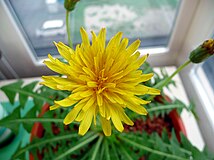Taraxacum
| Taraxacum Temporal range: Miocene–recent
| |
|---|---|
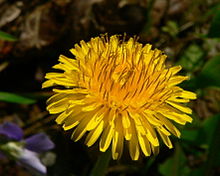
| |

| |
| A dandelion flower head composed of numerous small florets (top). The seedhead is shown below it. | |
| Scientific classification | |
| Kingdom: | Plantae |
| Clade: | Tracheophytes |
| Clade: | Angiosperms |
| Clade: | Eudicots |
| Clade: | Asterids |
| Order: | Asterales |
| Family: | Asteraceae |
| Subfamily: | Cichorioideae |
| Tribe: | Cichorieae |
| Subtribe: | Crepidinae |
| Genus: | Taraxacum F. H. Wigg. |
| Type species | |
| Taraxacum officinale[2] | |
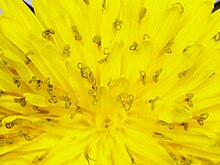
Taraxacum (/təˈræksəkəm/)[3] is a large genus of flowering plants in the family Asteraceae, which consists of species commonly known as dandelions. The scientific and hobby study of the genus is known as taraxacology.[4] The genus is native to Eurasia and North America, but the two most commonplace species worldwide, T. officinale (the common dandelion) and T. erythrospermum (the red-seeded dandelion), were introduced from Europe into North America, where they now propagate as wildflowers.[5] The plant thrives in temperate regions and can be found in yards, gardens, sides of roads, among crops, and in many other habitats.[6] Both species are edible in their entirety[a] and have a long history of consumption.[7] The common name dandelion (/ˈdændəlaɪ.ən/ DAN-də-ly-ən; from French dent-de-lion 'lion's tooth') is also given to specific members of the genus.
Like other members of the family Asteraceae, they have very small flowers collected together into a composite
In general, the leaves are 50–250 mm (2–10 in) long or longer, simple, lobed-to-pinnatisect, and form a basal
The flower head is surrounded by bracts (sometimes mistakenly called sepals) in two series. The inner bracts are erect until the seeds mature, then flex downward to allow the seeds to disperse. The outer bracts are often reflexed downward, but remain appressed in plants of the sections Palustria and Spectabilia. Between the pappus and the achene is a stalk called a beak, which elongates as the fruit matures. The beak breaks off from the achene quite easily, separating the seed from the parachute.[citation needed]
Description

The species of Taraxacum are
The seeds are able to cover large distances when dispersed due to the unique morphology of the pappus which works to create a unique type of vortex ring[16][17] that stays attached to the seed rather than being sent downstream. In addition to the creation of this vortex ring, the pappus can adjust its morphology depending on the moisture in the air. This allows the plume of seeds to close up and reduce the chance to separate from the stem, waiting for optimal conditions that will maximize dispersal and germination.[18][19]


Similar plants

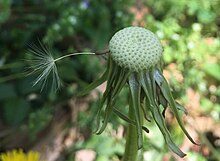
Many similar plants in the family Asteraceae with yellow flowers are sometimes known as false dandelions. Dandelion flowers are very similar to those of cat's ears (Hypochaeris). Both plants carry similar flowers, which form into windborne seeds. However, dandelion flowers are borne singly on unbranched, hairless and leafless, hollow stems, while cat's ear flowering stems are branched, solid, and carry bracts. Both plants have a basal rosette of leaves and a central taproot. However, the leaves of dandelions are smooth or glabrous, whereas those of cat's ears are coarsely hairy.[citation needed]
Early-flowering dandelions may be distinguished from
Other plants with superficially similar flowers include
Classification
The genus is
As of 1970, the group is divided into about 34 macrospecies or
About 235
Botanists specialising in the genus Taraxacum are sometimes called taraxacologists,[24] for example Gunnar Marklund, Johannes Leendert van Soest or A.J. Richards.[25]
Selected species
- Taraxacum albidum, the white-flowered Japanese dandelion, a hybrid between T. coreanum and T. japonicum
- Taraxacum algarbiense
- Taraxacum aphrogenes, the Paphos dandelion
- Taraxacum arcticum
- Taraxacum balticum
- Taraxacum brachyceras
- Taraxacum brevicorniculatum, frequently misidentified as T. kok-saghyz and a poor rubber producer[26]
- Taraxacum californicum, the California dandelion, an endangered species
- Taraxacum centrasiaticum, the Xinjiang dandelion
- Taraxacum ceratophorum, the horned dandelion, considered by some sources to be a North American subspecies of T. officinale (T. officinale subsp. ceratophorum)[27]
- Taraxacum coreanum
- Taraxacum desertorum
- Taraxacum erythrospermum, the red-seeded dandelion, often considered a variety of T. laevigatum (i.e., T. laevigatum var. erythrospermum)[28]
- Taraxacum farinosum, the Turkish dandelion
- Taraxacum holmboei, the Troödos dandelion
- Taraxacum hybernum
- Taraxacum japonicum, the Japanese dandelion, no ring of smallish, downward-turned leaves under the flower head
- Taraxacum kok-saghyz, the Kazakh dandelion, which produces rubber[29][26]
- Taraxacum laevigatum, the rock dandelion, achenes reddish brown and leaves deeply cut throughout the length, inner bracts' tips are hooded
- Taraxacum lissocarpum
- Taraxacum minimum
- Taraxacum mirabile
- Taraxacum officinale (syn. T. officinale subsp. vulgare), the common dandelion, found in many forms
- Taraxacum pankhurstianum, the St. Kilda dandelion
- Taraxacum platycarpum, the Korean dandelion
- Taraxacum pseudoroseum
- Taraxacum rubifolium, a near-extinct species.[30][31]
- Taraxacum suecicum
Cultivars
- 'Amélioré à Coeur Plein' yields an abundant crop without taking up much ground, and tends to blanch itself naturally, due to its clumping growth habit.
- 'Broad-leaved' - The leaves are thick and tender and easily blanched. In rich soils, they can be up to 60 cm (2') wide. Plants do not go to seed as quickly as French types.
- 'Vert de Montmagny' is a large-leaved, vigorous grower, which matures early.[32]
History

Dandelions are thought to have evolved about 30 million years ago in Eurasia.[33] Fossil seeds of Taraxacum tanaiticum have been recorded from the Pliocene of southern Belarus.[34] Dandelions have been used by humans for food and as an herb for much of recorded history. They were well known to ancient Egyptians, Greeks and Romans, and are recorded to have been used in traditional Chinese medicine for over a thousand years. The plant was used as food and medicine by Native Americans.[35] Dandelions were probably brought to North America on the Mayflower for their supposed medicinal benefits.[36]
Etymology

The Latin name Taraxacum originates in
Common names
The English name, dandelion, is a
The English folk name "
Nutrition
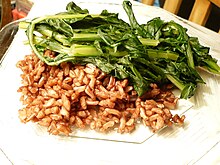
Raw dandelion greens contain high amounts of vitamins A, C, and K, and are moderate sources of calcium, potassium, iron, and manganese.[46] Raw dandelion greens are 86% water, 9% carbohydrates, 3% protein, and 1% fat.[46] A 100 gram (3+1⁄2oz) reference amount supplies 45 Calories.[46]
Phytochemicals
The raw flowers contain diverse
Properties
Edibility

The entire plant, including the leaves, stems, flowers, and roots, is edible and nutritious, with nutrients such as vitamins A and K as well as calcium and iron.
The flower
Dye
The yellow flowers can be dried and ground into a yellow-pigmented powder and used as a dye.[57]
Allergies
Dandelion pollen may cause allergic reactions when eaten, or adverse skin reactions in sensitive individuals. Contact dermatitis after handling has also been reported, probably from the latex in the stems and leaves.[58][unreliable source?][medical citation needed][59]
Herbalism
Dandelion has been used in traditional medicine in Europe, North America, and China.[47] It's possible that Dandelion has physiological effects in Type 2 Diabetes [60][61] Dandelion components play a significant role in the control of lipid metabolism and adipogenesis, which means dandelion can potentially be used to treat obesity.[62] Dandelion leaves and dandelion root extracts have been shown to possibly decrease growth of cancer cells.[63][64]
Food for wildlife
Dandelions do not depend on wildlife for distribution or pollination; however much of wildlife benefits from the abundance of the plant. Rabbits, wild turkeys, white-tailed deer, eastern chipmunks, bobwhite quail, and many species of birds will consume the seeds and foliage. Additionally, many insects will collect nectar from the flower, especially in early spring when there are very few other flowers in bloom.[65]

Seeds
Taraxacum seeds are an important food source for certain birds (linnets, Linaria spp.).[66]
Nectar
Szabo studied nectar secretion in a dandelion patch over two years (59.2 and 8.9 flowers per square metre (5.50 and 0.83/sq ft) in 1981 and 1982). He measured average nectar volume at 7.4
Dandelions are also important plants for Northern Hemisphere bees, providing an important source of nectar and pollen early in the season.[69] They are also used as a source of nectar by the pearl-bordered fritillary (Boloria euphrosyne), one of the earliest emerging butterflies in the spring.[citation needed]
Leaves
Dandelions are used as food plants by the larvae of some species of Lepidoptera (butterflies and moths).
Invasive species

Dandelions can cause significant economic damage as an invasive species and infestation of other crops worldwide;[70] in some jurisdictions, the species T. officinale is listed as a noxious weed.[70][71] It can also be considered invasive in protected areas such as national parks. For example, Denali National Park and Preserve in Alaska lists Taraxacum officinale as the most common invasive species in the park [72] and hosts an annual "Dandelion Demolition" event where volunteers are trained to remove the plant from the park's roadsides.[73]
Benefits to gardeners
With a wide range of uses, the dandelion is cultivated in small gardens to massive farms. It is kept as a
Cultural importance
It has been a Western tradition for someone to blow out a dandelion seedhead and think of a wish they want to come true.[75]
Five dandelion flowers are the emblem of White Sulphur Springs, West Virginia.[76] The citizens celebrate spring with an annual Dandelion Festival.[77]
The dandelion is the official flower of the
Inspiration for engineering
The ability of dandelion seeds to travel as far as a kilometer in dry, windy and warm conditions, has been an inspiration for designing light-weight passive drones.
In 2018, researchers discovered that dandelion seeds have a separated vortex ring.[79] This work provided evidence that dandelion seeds have fluid behavior around fluid-immersed bodies that may help understand locomotion, weight reduction and particle retention in biological and man-made structures.
In 2022, researchers at the University of Washington demonstrated battery-free wireless sensors and computers that mimic dandelion seeds and can float in the wind and disperse across a large area.[80]
As a source of natural rubber
Dandelions secrete
Notes
- ^ Eating the seedhead is not recommended.
References
- PMID 28182646.
- JSTOR 1222201.
- ^ "Taraxacum". Merriam-Webster.com Dictionary.
- ^ Greenwood, Barbara (2015). "Don't Dismiss the Dandelion".
- ^ a b Brouillet, Luc. "Taraxacum F. H. Wiggers, Prim. Fl. Holsat. 56. 1780". Flora of North America.
- PMID 36662824.
- ^ "Wild About Dandelions". Mother Earth News. 1 April 2008.
- ^ "Let dandelions grow. Bees, beetles and birds need them". The Guardian. 12 May 2015.
- University of Wisconsin. Archived from the originalon 22 October 2008.
- McGraw-HillCompanies. 2003. Retrieved 26 January 2013.
- CollinsDictionary.com. HarperCollins.
- ^ "blowball". InfoPlease Dictionary.
- ^ "dandelion clock". Longman English Dictionary Online. Pearson. Retrieved 2 June 2019.
- ^ "clock". The American Heritage Dictionary of the English Language (5th ed.). HarperCollins.
- ISBN 9780521707725.
- S2CID 52988814.
- S2CID 198429309.
- )
- OCLC 988948576.
- ISBN 978-1408179505.
- ^ S2CID 17903814.
- ^ JSTOR 2430530.
- ISBN 978-0-901158-25-3.
- ^ "Overlooked dandelion diversity in BC (and everywhere in North America?)". iNaturalist Community Forum. 17 January 2020. Retrieved 31 October 2023.
- ISBN 978-0-901158-25-3.
- ^ PMID 30760810.
- ^ "Alberta Biodiversity Monitoring Institute - Taraxacum ceratophorum". Archived from the original on 8 July 2014. Retrieved 29 August 2013.
- ^ "Flora of North America". Efloras.org. Retrieved 29 August 2012.
- ^ "Plants for a Future Search Error". www.ibiblio.org. Retrieved 17 April 2017.
- ^ "Taraxacum rubifolium". iNaturalist. Retrieved 2 March 2024.
- ^ Øllgaard, Hans (1 January 1996). "The red-leaved Faroese dandelion, Taraxacum rubifolium Rasmussen | Fróðskaparrit -". Faroese Scientific Journal.
- ^ "Dandelion". Fondation Louis Bonduelle. 5 October 2016.
- ^ "Gardening in Western Washington: Dandelions". Gardening.wsu.edu. 4 May 2003. Archived from the original on 26 June 2012. Retrieved 29 August 2012.
- ^ The Pliocene flora of Kholmech, southeastern Belarus and its correlation with other Pliocene floras of Europe by Felix Yu. VELICHKEVICH and Ewa ZASTAWNIAK - Acta Palaeobot. 43(2): 137–259, 2003
- ISBN 978-0-520-03261-3.
- ^ "Dandelions". Maine Organic Farmers and Gardeners Association. Archived from the original on 20 February 2017. Retrieved 17 April 2017.
- ^ Reported in An Etymological Dictionary of the English Language, by Walter W. Skeat (1888) (Downloadable at Archive.org). In An Etymology Dictionary of Modern English by Ernest Weekley (1921) it is reported that Arabic طرشقون tarashaqun is derivable in turn from Persian تلخ چکوک talkh chakok, bitter herb (Downloadable at Archive.org).
- ^ S. Potter & L. Sargent (1973) Pedigree: essays on the etymology of words from nature. Collins New Naturalist series Volume 56
- ISBN 978-0-486-22644-6.
- ^ "Common Dandelion_Family: Asteraceae" (PDF).
- ISBN 978-1-58574-274-5.
Swine's Snout.
- ^ "Dandelion clock". TheFreeDictionary.com.
- ^ Taylor, Joseph (1819). Antiquitates curiosae: the etymology of many remarkable old sayings, proverbs and singular customs explained by Joseph Taylor (2nd ed.). T&J Allman. p. 97.
- ^ Anon. "Dandelion - far more than a weed" (PDF). Frapez.com. Frapez soothie spa. Archived from the original (PDF) on 11 July 2011. Retrieved 30 May 2010.
- ^ "Den virtuella floran: Taraxacum F. H. Wigg. - Maskrosor" (in Swedish). Linnaeus.nrm.se. Retrieved 3 July 2010.
- ^ a b c "Dandelion greens, raw". Nutritiondata.com, Conde Nast Inc. Retrieved 7 March 2011.
- ^ PMID 16950583.
- ^ "Carotenoids". Micronutrient Information Center, Linus Pauling Institute, Oregon State University. 1 July 2016. Retrieved 27 June 2019.
- PMID 10521720.
- ^ S2CID 43872064.
- ^ Osborne, Tegan (11 May 2016). "Edible weeds that are safe to eat and how you can use them". ABC News (Australia). Retrieved 24 May 2021.
- ISBN 978-0-684-80001-1.
- ^ sautéed Dandelion Greens, ItalianFoodForever.com
- ^ Bergo, Alan. "Lebanese Dandelions with Carmalized Onions". Forager Chef. Forager Chef. Retrieved 16 March 2024.
- ISBN 978-960-631-179-6.
- New Jersey On-Line. Retrieved 7 March 2011.
- OCLC 219915765.
- ISBN 978-1-4116-4486-1.
- ^ Lovell CR, Rowan M. Dandelion dermatitis. Contact Dermatitis. 1991 Sep;25(3):185-8. doi: 10.1111/j.1600-0536.1991.tb01826.x. PMID 1838315.
- ^ Wirngo FE, Lambert MN, Jeppesen PB. The Physiological Effects of Dandelion (Taraxacum Officinale) in Type 2 Diabetes. Rev Diabet Stud. 2016 Summer-Fall;13(2-3):113-131. doi: 10.1900/RDS.2016.13.113. Epub 2016 Aug 10. PMID 28012278; PMCID: PMC5553762.
- ^ Mohanta YK, Mishra AK, Nongbet A, Chakrabartty I, Mahanta S, Sarma B, Panda J, Panda SK. Potential use of the Asteraceae family as a cure for diabetes: A review of ethnopharmacology to modern day drug and nutraceuticals developments. Front Pharmacol. 2023 Aug 3;14:1153600. doi: 10.3389/fphar.2023.1153600. PMID 37608892; PMCID: PMC10441548.
- PMID 23956107.
- PMID 18425335.
- PMID 27564258.
- ^ "Out My Backdoor: In Defense of Dandelions | Department Of Natural Resources Division". georgiawildlife.com. Retrieved 16 October 2023.
- .
- S2CID 85676502.
- ^ Tibor I. Szabo, Nectar Secretion in Dandelion, Journal of Apicultural Research, Volume 23, 1984 - Issue 4
- ISBN 978-1-152-86271-5.
- ^ doi:10.4141/P01-010.
- ISSN 0097-7136.
- ^ Non native species National Park Service
- ^ Love, Colleen Coulon Denali’s Dandelion Demolition returns after 2020 hiatus KTNA, June 17, 2021
- ^ Anon. "Companion Planting for Vegetables & Plants". Country living and farm lifestyles. countryfarm-lifestyles.com. Retrieved 7 March 2011.
- ISBN 9780811857161– via Google Books.
- ^ "Welcome to Main Street White Sulphur Springs...Make it home". Wssmainstreet.org. Archived from the original on 4 June 2010. Retrieved 3 July 2010.
- ^ "White Sulphur Springs hosts West Virginia Dandelion Festival". Nexstar Media Inc. 27 May 2023. Retrieved 16 April 2024.
- ^ "Songs of the University of Rochester". Lib.rochester.edu. 14 January 2010. Retrieved 3 July 2010.
- S2CID 52988814.
- S2CID 247499662.
- Science Daily. 28 October 2013. Retrieved 22 November 2013.
- ^ "Fraunhofer and Continental come together when the dandelion rubber meets the road". 14 October 2013. Retrieved 14 December 2016.
- ^ "Linglong to fund research into dandelion rubber | Rubber and Plastics News". 20 December 2017.
External links
 Media related to Taraxacum at Wikimedia Commons
Media related to Taraxacum at Wikimedia Commons- Frail, F.S. (23 June 1981). "Unloved in bloom, unwelcomed in summer: Weeding through the lore of the dandelion". The Boston Phoenix. Retrieved 3 April 2024.



